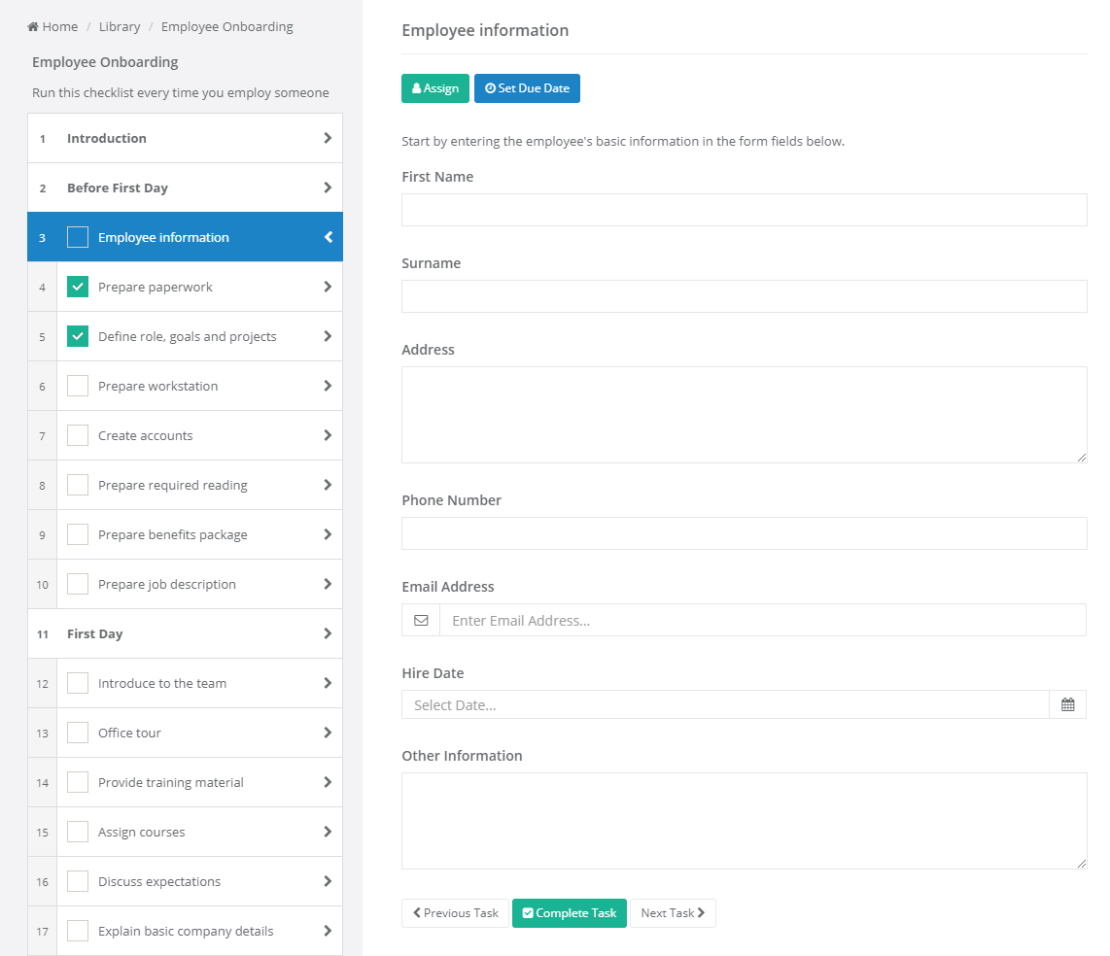Writing Standard Operating Procedures
Launching a new business or improving one that has existed for years requires some of the same steps to get everything functioning like a well-oiled machine. Not only do you need to identify important long-term projects and daily tasks, you also need to identify who will do them best and how to approach them to get them done correctly in the shortest amount of time possible.
A standard operating procedure includes the answers to all these questions. Creating one for every action necessary to grow your business is an integral part of deciding how streamlined your path to success will be. What are they? How do you make them? And how do you know the ones you create will help you reach your goals?
Learn how to create the best standard operating procedures with these 16 essential steps.
Step #1 – Choose SOP Presentation Methods
Standard operating procedures work well in various formats. Before you begin making rules or step-by-step lists for different tasks, pick a presentation method. Most large corporations use the ISO-9000 standard. Smaller companies and individuals may use different methods of ensuring their SOP's satisfy all professional needs. ISO-9000 includes accepted principles of quality management that work for businesses in any industry or niche. International companies may also diverge from this method, and some companies may choose to create their own SOP presentation methods. No matter what you choose, everyone involved must agree on the same format.
Simple Checklists
Individuals or small teams may only need a simple task or to-do list to keep everyone on the right path. In fact, it would be a bit silly for a solopreneur to create anything more complicated. Checklist is quick, easy, and clear. They are often the first step in crafting more complicated SOP's, too. A person who performs a specific task efficiently can write down their process for later refinement or so other people can follow it exactly.
Complicated Linear Checklists
Instead of a line by line to-do list, these more complex SOP formats include a wide variety of detail about each step in the process. They may look more like a classic outline with tiered details under each step to improve clarity and understanding. This way of formatting standard operating procedures also works better if multiple people are going to be working on one project or task at the same time. The additional details allow for more diversion of variables and assignment of different steps to different people.
CheckFlow favors these complex linear checklists for most SOP formatting jobs. We want to present you with a watertight solution that allows anyone to fully understand and implement everything necessary to get a job done right.
Here is a screenshot of our Employee Onboarding Checklist.
Flowcharts and Process Diagrams
A flow diagram often allows for more precise communication of all of the steps in and SOP. Also, some workers may simply understand graphical representations more than textual ones. Flow diagrams help with the visualization process of the overall procedure but may not seem as actionable as simpler lists. In many cases, a company may have both a flowchart and a linear checklist to better explain the overall process in the beginning.
All of the other steps outlined below in this article focus on writing standard operating procedures in a complex linear checklist format. This is the most commonly used and generally the most effective for all types of businesses and employees.
Step #2 – Set Up Smart Collaboration
Dictating procedural changes to the people responsible for certain tasks is not likely to go over well. Instead, create a system of collaboration with employees and stakeholders will end up following your standard operating procedures after they are finalized. Not only will you get experienced information about how the tasks are completed and data to weigh processes against outcomes, but you will end up with a more appreciative team if you make them part of the process.
As a manager or business leader, these are the people you have hired to do these things. It takes a team to develop processes makes sense for everybody involved. Teamwork matters not only for getting the best end result in the most efficient manner but also for increasing morale and a sense of ownership over their tasks. In a nutshell, people are more likely to work effectively when they have them say in what they do and how they do it.

Step #3 – Determine Your SOP Objectives
What is the desired outcome? Obviously, your SOP must get everyone who follows it to the same place when it comes to completions of a task or project. The answer to this question depends on whether the objectives are new or if they have existed for a while and you are trying to make improvements. Priorities can range from a client stakeholder or tweaking productivity metrics just a bit higher.
If you have been tasked with developing standard operating procedures for an existing process, part of this step deals with identifying pain points or moments of weakness in the existing checklist. What holds up the process or causes the most confusion and inefficiency? In order to figure this stuff out, you need to document the existing methods, collect resultant data, and tweak the instructions until you reach whatever objective you define here.
Step #4 – Pick a Format for Standard Operating Procedures
How will you deliver your standard operating procedure to the people who need to see and understand it? Large corporations may choose formal reports or premade templates decided upon by higher ups. These will undoubtedly start with the cover or reference page, include a list of chapters, and finally a detailed, multi-tier checklist that shares the processes in detail.
Smaller companies may have a single page or a small packet that outlines everything. Startups and team-led groups usually opt for a more informal approach. At CheckFlow, you can create whatever type of SOP format you need in your company. We offer convenient PDF exports that allow for flexible use and access.
Step #5 – Define Limits and Scope of Every Process
A large part of creating a new standard operating procedure for specific task or collection of related tasks involves defining individual limits for the people who are actually doing the work. Do not create an SOP that includes everything that goes into a particular type of project. Instead, create a separate one that operates within the scope of a department, team, or employee type.
Of course, to get an entire project done often includes collaboration between different groups of employees. The overall workflow in an office or other location can incorporate multiple SOP's that combine at certain points. However, you need to determine who benefits from each standard operating procedure and design processes that allow them to do their part of the job efficiently without confusion. One process gets one type of employee from point A to point B. If you need to expand the scope to groups, you may have to make a more complex SOP checklist that defines intersection points as well.
Step #6 – Choose an Agreed-Upon SOP Style
Along with the format decisions described in Step #4, the people collaborating on the standard operating procedure creation must pick a style they are all comfortable with. This generally has to do with the level of formality used in the language and how meaning is conveyed clearly to the people who need to understand it.
These days, casual language has become more prevalent than ever before. However, the status of the company and the industry in part informs the writing style for SOP's. In order to communicate effectively, we suggest the following:
- Focus on Actions – Verbs are powerful words that tell people what they should do right away. Since SOP documents are sometimes quite long and involved, it makes sense to get to the point of each step from the start.
- Use Concise Language – Do not waste time with frivolous language, abstract reasoning, or feel-good comments. Write with clarity in order to convey what you want the employee to do, how, and when. You can cover the why in a meeting.
- Scannable Structure – Avoid large blocks of text. People are much less likely to read them. If you want the workers to follow the SOP, make it easier for them to scan to the important information that pertains to them specifically. This also helps them refresh their understanding of the process as needed.
Step #7 – Use Company-Specific Notation
This only pertains to companies or organizations that have their own in-house notation systems. Large corporations are more likely to have these precise rules you have to follow when creating new SOP's. The majority adopt a standardized form like BPMN. However, just because this is seen as a standardized "language" for big business does not mean you have to use it in yours. If you ever collaborate with other companies who do, it may make it easier to share your operational processes with them more easily.
Step #8 – List the Process Steps

You have finally come to the meat of the entire standard operating procedure creation process. Get together with your team of superiors and the employees actually doing the work and collaborate on a step-by-step process that results in exactly what you all want. Ask questions, invite input, and keep track of potential problems and suggestions that may be used in the future even if they are not incorporated now.
Create the skeleton of a process that can stand on its own merit. Then, go back and flesh it out with sub-tasks and other details necessary to get the best results possible from the employees who will follow it. If you use the CheckFlow system, this entire step becomes much easier as you can incorporate multiple levels of checklists to create the best possible SOP for each task. Sub-checklists minimize confusion and guesswork while maintaining an actionable workflow at all times.
Step #9 – Brainstorm Potential Failure Scenarios
At this point, most people involved with creating the SOP probably think it will work great. It has not been tested yet, and you have not collected any data to back up these assumptions. Before you get to those steps, take some time to think of any possible problems that could arise during the process.
The brainstorming session can include everything from hypotheticals to calculations that run possibilities through established models. These types of preliminary tests allow you to tweak things before you put the whole process into action. If something goes wrong in the first part of the process, how will that affect steps below it?
It is possible to change the operating procedures at this time if anything obvious pops up. However, you might consider holding on to the potential issues until you do more precise and practical tests later on.
Step #10 – Determine How Processes Can Be Measured
The creation of a standard operating procedure checklist or chart means nothing if you have no way of collecting data to show if it is improving work function or not. Define metrics that allow you to determine this objectively. Only with this information can you improve the process as necessary.
The measurement methods will change greatly depending on what the process focuses on. If you create an SOP for your sales team, for example, some of the metrics may include the number of leads generated, conversion percentages, total sales revenue, and more. A process metric for our telephone customer service may include anything from the length of the call to a satisfaction rating the customer gives after-the-fact.
This step in the overall SOP creation activity lets you establish questions to ask after you put the process in place and allows you to collect appropriate information that helps you make changes to improve everything from employee morale to work speed. In the end, determining how you measure the success of a new or changed SOP determines how well it aligns with the company's overall goals.
Step #11 – Run Practical Tests for Every SOP
You have created a plan, collaborated with group leaders and employees, and figured out as many hypothetical results as you possibly can. Now is the time to actually test your standard operating procedures with the people who will be implementing them throughout the course of their workday. If you have larger groups will perform the same duty, such as a sales team of 10 people or a dozen in the customer service area, choose a small percentage of them to perform using the new SOP's for a few days or weeks. This gives you practical feedback to make sure that they understand the process, can perform it reliably, and it gives you the outcome you truly want.
This old versus new method testing should tell you what you need to know when it comes to productivity and improved outcomes. Even if things originally look like they work smoothly, do not skip the rest of the steps in this SOP creation process. Surety makes more sense than speed when it comes to shifting how groups of employees function across the board.
CheckFlow makes it simple to perform your testing. Create your SOP template, run multiple instances of your SOP as checklists, and monitor in real-time using our dashboard. Everything is tracked so it's easy to track how your SOP performed.
We even have an analytics dashboard to provide you with the stats you need to easily track how well your SOPs are performing over time.
Build a template of your SOP using our drag and drop designer.
Run or schedule multiple instances of your SOP template as checklists.
Monitor and control your SOPs using our real-time dashboard
Build a template of your SOP using our drag and drop designer.
Run or schedule multiple instances of your SOP template as checklists.
Monitor and control your SOPs using our real-time dashboard
Step #12 – Get Feedback from Your Superiors
Unless you are the company owner or the CEO, you must have superiors who need to sign off on the standard operating procedures you and your team create. Hopefully, the people with this responsibility have the knowledge and experience necessary to make sure you did a good job. Ideally, you want a pair of fresh eyes that still has the practical knowledge necessary to make sure every step in the process will have a real benefit.
Even if you do run your own small business, you may want an investor, mentor, or even a long-term customer look over the SOP before implementation.
Step #13 – Make the Optimization Process Clear
Although the goal is to create standard operational procedures that work now, next week, and next year, no objectives or methods to reach them remain static forever. SOP's are living documents that can change and grow over time. With this in mind, it is important to figure out how this process happens.
The people who come up with these processes must work together to follow all the steps toward a final solution. Different people take different roles, have strengths and weaknesses, and may suggest or do things that do not jell with the rest. Collaboration and agreement remain important during any future optimization. Personal differences aside, the key factors in changing and SOP are the metrics and data collected from the outcome of the process itself. This can incorporate anything from a manager's report to predictive AI data analysis.

Step #14 – Do Not Forget Risk Assessment
Even the clearest and most understandable standard operating procedure document can fall down when put into practical use if too much risk is involved with the process. This pertains to companies in industries as diverse as software development, transportation, and the medical field. Before putting the final stamp of approval on any SOP, run it through a risk assessment to make sure your actual workers will not run into any potentially serious problems when they tried to perform duties as instructed. No increase in productivity or profit overrides the need for safety.
Step #15 – Create a Flow Diagram for Visual Learners
Some employees understand better with a graphical chart rather than a textual list of steps to follow. After finalizing your standard operating procedures for whatever activities an employee must do to satisfy their job description, transform it into a flow diagram or workflow map. These include visual overviews with understandable icons and structure to augment understanding. The end goal is to help every worker understand their part of the entire process. Not only can they see where they fit, but their role in the company's success makes more sense to them. Improved understanding leads to greater efficiency and faster results.
Step #16 – Final Step – Implementation of SOPs
You've done the research, planning, and optimization. Your standard operating procedures give employees everything they need to move forward productively and with a defined end goal that helps the company overall. As long as you paid attention to the previous 15 steps, you now have all processes in place to optimize every aspect of business function.
